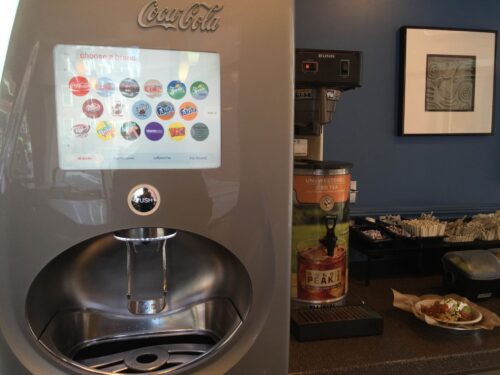Adjusting to the salty-sweet realities of American food.
There’s often a transition I have to go through after settling down in a new place. In the first few weeks every time I buy something, my mind calculates how much the price would be in CNY and compares that to how much I’d pay at home for the same thing. Having left CVS empty handed more than once, because 30 RMB should get me far more than 30 seedless grapes, I have come to realize that this mentality will not be sustainable, especially at Harvard, where fresh produce isn’t available, in variety, all the time.
This problem becomes a particular pain when I go to eat at Chinese restaurants, where my idea of what is “Chinese” is constantly contested. The only way I get past the mental hurdle of what I eat is not worth the menu price, is to swap all the dollar signs for the Yuan. A few weeks into freshman year, when my friend ordered the traditional Zhajiang Noodles, which is something that has a very specific taste, it came out sweet salty, I lost all faith in Boston Chinese food. Now, if someone asks me to eat Chinese with them, I tell myself that I’m having something uniquely American so there is no issue of “authenticity.”
Two weeks into the school year, my friend from China came up to me horrified and said that she couldn’t believe how people here lived on pure hunks of sugar (cookies) and salt (chips). I would have thought she was exaggerating if I wasn’t living in the US. But now that I am, I’ve realized that it’s not so much of a hyperbole.
You can tell by looking at the menu of any Chinese restaurant in Boston that desserts aren’t a staple of homegrown Chinese meals. There are usually about 100 to 200 dishes at a typical Chinese restaurant in China, with possibly 10 small plates of dim sum that aren’t even that sweet. Here, it feels like the reverse: 100-200 kinds of dessert and possibly not even 10 vegetables dishes. It’s like a real life version of Candyland.
A few weeks ago, at the freshman break brain in Annenberg, apple, blueberry, and cherry pies were served. While everyone else was busy socializing, I sat there silently, astonished by the how good pie could taste. I used to be genuinely baffled by how the people on Biggest Losers, which they aired in China, got that fat. I mean, at one point, doesn’t it become impossible to eat anymore? Wouldn’t your stomach explode? Surrounded by sugar, at every possible event, restaurant, meal, food store, I no longer find obesity impossible to understand. Now, what puzzles me now is how people stay skinny.
Maybe my friend shouldn’t have come to me so surprised. After all, it’s not that Chinese people think of America as a particularly healthy nation. We do, in fact, associate the American diet with burgers, ice cream, clam chowder, fries, donuts, brownies, and pizza. Don’t get me wrong, we ate American food in China, just not every day: once in a blue moon, when we became jaded by the variety of Chinese cuisines, we’d get pizza, and it’d tasted fine.
As my newfound love of sugar began to water down, just a bit, I began to worry about my health. Before coming to Harvard, I had no clue that people could work in hospitals as nutritionists. I always thought of them as mysterious people who floated around blogging and randomly popping up on television shows, telling people what to eat or drink. Nevertheless, I decided it was probably a good time to meet one.
My nutritionist told me that a muffin for breakfast and a box of almonds for lunch didn’t count as a balanced diet. I couldn’t agree more but compared to my high school, which managed to serve great food to three thousand students for each meal, Annenberg is not filled with too many choices.
When I think of eating vegetables in China I always think of dishes that are stir-fried and involve many intricate decisions that chefs have to make meticulously. Here, the cooking process is stopped and finished before it’s even started.
My roommate said that people here cook with their eyes, not with their tongues. I’m not even sure if they cook with their eyes. I mean do I really need a chef to boil vegetables, slice up tomatoes, and line them up orderly on the counter? There’s no depth of flavor, and no thought in the cooking process (pizzas, burgers, fries, and cookies are not delicate, nor is the cooking process complex), which makes serving large portions easy, and mishaps difficult. The grand prize however, for the ultimate laziest invention, goes to the salad (which sadly is the go to option for being healthy). I thought we fed rabbits lettuce?
We certainly haven’t lost all of our creativity with food. Everyday, I have to face the challenge of choosing between half and half, non-fat, and whole milk at Starbucks, which always makes me nervous. Starbucks may disorient me but the soda machine at Qdoba brings me to the edge of a mental breakdown. I grew up with three sodas: Sprite, Coke, and Fanta. At Qdoba, there were at least fifty choices: cherry coke, cherry coke zero, cherry diet coke–the list goes on.
I don’t know if it’s because people here take the food for granted but it seems like nobody is terribly upset. At least no one that I know of is addressing the problem in a way that parallels the scale of the problem itself. Why is being healthy so complicated here?
It wasn’t easy back home, it’s just far more difficult here. And so far, the American diet just doesn’t make the cut for me.
Sophie Wang ’19 (sophiewang@college.harvard.edu) is still trying to find an alternative to salads.

